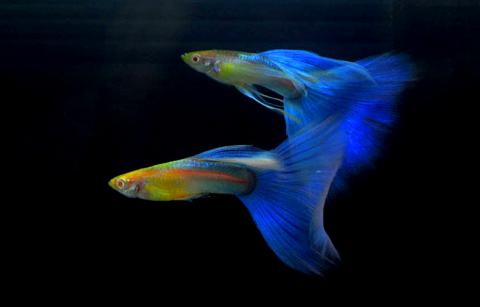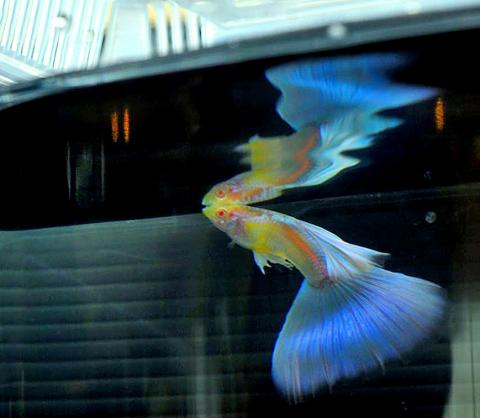Not many people would call themselves gods, but for guppy breeders like Andrew Lim, it’s pretty darn close to the truth.
“You can create whatever you want,” Lim says. It’s instant gratification genetic manipulation, as guppies can give birth to between 20 and 200 fry per month. The frequency and quantity allows for a huge pool of candidates to mix and match with — it’s like evolution in fast forward.
Lim, who hails from Malaysia, is sitting in a space walled off by fishtanks in the middle of a busy mall in Yilan City. He’s one of the five judges for the 9th World Guppy Beauty Competition, which received 198 submissions this year from five countries. The fish are judged according to appearance and activity in 18 strain and age categories, with the winners taking home cash.

Photo: Han Cheung, Taipei Times
Breeder Chuck Lu (盧禹辰) says that Taiwan is the top guppy breeding country in the world. He may be exaggerating, but note that for the past four years, Taiwanese breeders have dominated the World Guppy Contest, which is considered the world championships with an average of 600 submissions. Held in a different country each year, Taiwan will be hosting this summer’s event for the second time since its inception in 1996.
GENETIC MIX AND MATCH
Curious passersby examine the fish, which probably appear quite different from the ones found in Trinidad by their namesake, British naturalist Robert John Lechmere Guppy. There’s a multitude of colors, even albinos. Some have back fins that droop over their sides, and others boast large, fanned tail fins — these belong to the “evening gown” category. Lu says Taiwan is the pioneer of these souped up fins.

Photo: Han Cheung, Taipei Times
Each tank has at least one male and female, with the male being the flamboyant one. The female is larger and duller, amounting to 10 percent of the total score. Lim says they require contestants to display both genders to prove that they are breeders and did not purchase the fish just for the contest.
“The judges need to have a basic understanding of genetics to tell if both fish belong to the same strain,” he says. “If not, the breeder is disqualified.”
Some have fins so large that they seem to be weighed down when they swim. Lim admits that this is a burden on the fish, which may shorten their lives by a few months. But pushing genetic boundaries seems to be the main draw for these enthusiasts — there’s even a “new strain” category for people who like to mix and match.
“You might wonder if the offspring of a blue guppy and red one will turn out to be purple,” breeder Wu Kun (吳焜) says. “But you don’t know what will happen until you do it. That’s why it’s fun. If it really turns out purple, maybe you’ll get to name this new strain.”
Lu describes his dream fish: metallic in the front, snake pattern in the middle and lace pattern for the tail. But he adds that it’s not enough just to create the fish — the ultimate goal is to stabilize the genetic pool so that at least 60 percent of the offspring carry the same characteristics.
Since the guppies have such a high birth rate, serious breeders require a lot of space — Wu has about 200 20-liter tanks, while some have up to 400. Even the casual hobbyist would require at least 10, he says.
DILIGENT BREEDERS
Wu enjoys comparing raising methods, which can cause fish of the same age to vary in size. He says his fish are smaller because he has a full-time job. It boils down to diligence in keeping the water clean and the food — the most expensive part of guppy raising is the newly-hatched brine shrimp, rich in protein and easily digestible, which is used to feed the young fish.
However, the fish start fasting a day before they arrive at a show — Wu says since they usually stay in the same tank for a few days, breeders want to reduce the feces produced to keep the water clean and the fish healthy. One breeder, however, rode his motorcycle six hours and back from Tamsui to Yilan just to change the water.
Foreign contestants don’t retrieve their fish as they might die from fasting and being in the same tank for too long. They are auctioned off at the show or adopted by local breeders.
Most winners are not around to receive their trophies. A representative from the Taiwan Guppy Association accepts all three top awards for its members, but he has no time to talk because he has the unenviable job of safely transporting more than 10 tanks back to Taipei.
Meanwhile, there’s little time to rest. With about three months left until July’s big bout, the breeders will be working diligently to make sure Taiwan remains on top of the guppy world.
“Competitions are the best way to maintain enthusiasm,” Wu says.

Most heroes are remembered for the battles they fought. Taiwan’s Black Bat Squadron is remembered for flying into Chinese airspace 838 times between 1953 and 1967, and for the 148 men whose sacrifice bought the intelligence that kept Taiwan secure. Two-thirds of the squadron died carrying out missions most people wouldn’t learn about for another 40 years. The squadron lost 15 aircraft and 148 crew members over those 14 years, making it the deadliest unit in Taiwan’s military history by casualty rate. They flew at night, often at low altitudes, straight into some of the most heavily defended airspace in Asia.

Beijing’s ironic, abusive tantrums aimed at Japan since Japanese Prime Minister Sanae Takaichi publicly stated that a Taiwan contingency would be an existential crisis for Japan, have revealed for all the world to see that the People’s Republic of China (PRC) lusts after Okinawa. We all owe Takaichi a debt of thanks for getting the PRC to make that public. The PRC and its netizens, taking their cue from the Chinese Communist Party (CCP), are presenting Okinawa by mirroring the claims about Taiwan. Official PRC propaganda organs began to wax lyrical about Okinawa’s “unsettled status” beginning last month. A Global

Taiwan’s democracy is at risk. Be very alarmed. This is not a drill. The current constitutional crisis progressed slowly, then suddenly. Political tensions, partisan hostility and emotions are all running high right when cool heads and calm negotiation are most needed. Oxford defines brinkmanship as: “The art or practice of pursuing a dangerous policy to the limits of safety before stopping, especially in politics.” It says the term comes from a quote from a 1956 Cold War interview with then-American Secretary of State John Foster Dulles, when he said: ‘The ability to get to the verge without getting into the war is

Like much in the world today, theater has experienced major disruptions over the six years since COVID-19. The pandemic, the war in Ukraine and social media have created a new normal of geopolitical and information uncertainty, and the performing arts are not immune to these effects. “Ten years ago people wanted to come to the theater to engage with important issues, but now the Internet allows them to engage with those issues powerfully and immediately,” said Faith Tan, programming director of the Esplanade in Singapore, speaking last week in Japan. “One reaction to unpredictability has been a renewed emphasis on